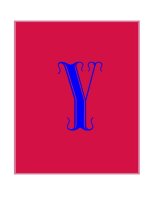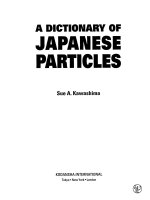One-Letter Words A Dictionary 3
Bạn đang xem bản rút gọn của tài liệu. Xem và tải ngay bản đầy đủ của tài liệu tại đây (162.86 KB, 18 trang )
E
E
E IN PRINT AND PROVERB
1. (phrase) This may be inscribed in a church
under the two tablets of the Ten Commandments:
“PRSVR PRFCT MN VR KP THS PRCPTS TN. The
Vowel E Supplies the Key.”
2. (phrase)
To give the big E means to brush off or
ignore. The E originally stood for elbow.
3. (in literature)
“E, candor of steam and of tents,
/Lances of proud glaciers, white kings, Queen
-
Anne’s- lace shivers.”
—Arthur Rimbaud, “Vowels”
4. (in literature)
French author Georges Perec wrote
an entire book, La Disparition, without using the
letter E.
This book was translated into English, also
without the E, under the title A Void.
5. (in literature)
“The peninsular landscape is full
of contrasts, paradoxes, and transformations.
The most prominent elements on the horizon are
forever silent, while smaller outgrowths have a
profound resonance. More amazing, though, is how
proximity to an E can actually transform an object
into something entirely different. (Luckily, as my
name is Sam, I remained the same.) I have sketched
a rough map of the terrain, but have yet to fi ll in
the details. I’m in no hurry, as the landscape of E
will remain forever etched in my memory.” —Craig
Conley, The Workbook of One- Letter Words
6. (in literature)
The title of a seven- minute Cana -
dian animated film directed by Bretislav Pojar.
A giant statue of the letter “E” arrives in the park.
One man sees it as “B”; they are preparing to cart
him off to the loony bin when a doctor arrives and
determines the man needs glasses. Then the king
E
41
arrives; he also sees “B.” He tries on the glasses,
sees “E,” and pins a medal on the doctor then has
his goon squad come and bash on everyone’s head
until they too see “B.” —Anonymous
7. (in literature)
“ ‘That’s half of the Electric Palace
symbol,’ Cal said. The Electric Palace was an elec
-
tronic store in Odyssey. ‘The E is missing, but that’s
it.’ ”
—Marshall Younger, Mysteries in Odyssey #1:
Case of the Mysterious Message
8. (in literature)
“E is the foundations, the pillar,
the console, and the architrave, all architecture
in a single letter.”
—Victor Hugo, quoted in ABZ by
Mel Gooding.
9. (in popular usage) “E- nough already! The ‘E’ has
come to be the favored letter in the e- world of Sili
-
con Valley. Have they forgotten about the other 25
perfectly good characters of the alphabet? Let us
start with the vowels that have been left to collect
dust as their compatriot has made its meteoric rise
to fame. What of ‘A’—was this not your fi rst vowel,
bringing to mind fond childhood memories of ABCs
and 123s? What of ‘I’—that character that embodies
the self and so much more? What of ‘O’—which is in
itself a perfect exclamation of any and all emotions?
What of ‘U’—counterpart to ‘I’ that gives it balance
and brings community? And sometimes ‘Y’—ever
questioning and pushing the boundaries? Does not
the power of the ‘E’ pale when placed next to the
stunning expansiveness of the other vowels? We
do not seek the demise of our friend ‘E,’ but merely
want to put it in its place, and provide an environ
-
ment in which all the other letters have room to
grow and fl ourish. —Anton Vowl, The Society for
the Preservation of the Other 25 Letters of the
Alphabet
E
42
10. n. A written representation of the letter.
“Make lots of Es,” she urged them. “E is one of the
most important letters there is.” Mrs. Michaels
wrote the letter E on five different little pieces of
paper. —Johanna Hurwitz, E Is for Elisa
11. n.
A device, such as a printer’s type, for reproduc-
ing the letter.
FROM ONE TO FIVE
12. n. One piece of Styrofoam packing material (in the
shape of an E).
13. n. In England, the second- class Lloyd’s rating for
the quality of a merchant ship.
14. n. One of four cardinal points on a compass
(abbreviation for East).
15. n.
The fifth in a series.
LEVELS OF ACHIEVEMENT
16. n. A U.S. government award (usually a pennant
bearing an E, symbolizing excellence) given to an
industrial organization.
17. n. A grade in school indicating “excellent.”
The grading system used during most of the period
before 1928 would appear confusing when com
-
pared to what is used today. For many years, stu-
dents were given four possible grades: E for excel-
lent, G for good, F for fair, and P for poor. —Gerald
F. De Jong, From Strength to Strength: A History of
Northwestern, 1882–1982
18. n.
One graded with an E.
E
43
MUSIC
19. n. A written or printed representation of a
musical note E.
He stayed for the second encore—an otherwise
inspiring version of Finlandia, sunk by the incapac
-
ity of the aforementioned hornist, Mr. Kelleher, to hit
a good E- fl at. —Brooks Hansen, Perlman’s Ordeal
20. n.
A string, key, or pipe tuned to the note E.
21. n. The fifth section in a piece of music.
Beginning with the letter E, that is, the main sec-
tion of the first movement [of Nikolai Sidelnikov’s
symphony The Duels], the series is a kind of sound
“matrix” consisting of thirteen sounds, where twelve
are changed and the thirteenth is a “random one”
which introduces an element of free development.
—M. Lobanova, Musical Style and Genre: History
and Modernity
22. n.
The third note in a C- major musical scale.
MISCELLANEOUS
23. n. The fifth letter of the alphabet.
It was a promiscuous, fawning surd, continually
merging with its neighboring consonants (“R” in
particular), confirming Lemprière’s view of [E] as
a perdifious little hieroglyph. —Lawrence Norfolk,
Lemprière’s Dictionary
What is the beginning of the end, the end of the
infinite, and the beginning of eternity? Answer: the
letter e. —Mark Barrenechea, Software Rules: How
the Next Generation of Enterprise Applications
Will Increase Strategic Effectiveness
E
44
24. n. Any spoken sound represented by the letter.
The sound vibration of the vowel E means “refl ec-
tion, reflectivity, relationship, placing, placement,
grid, mirror, echo.” —Joseph E. Rael, Tracks of
Dancing Light: A Native American Approach to
Understanding Your Name
25. n.
Something having the shape of an E.
He had decided on the “E” shape for the building to
keep it narrow enough to maximize the effi cient use
of natural light and because, had it run end to end
in a line, the amount of floor space required would
have made the building too long. —Vicki Boatright,
The Panama Canal Review
26. n.
A Roman numeral for 250.
27. n. Something arbitrarily designated E (e.g., a per-
son, place, or other thing).
28. n.
A shoe width size (narrower than EE, wider
than D).
29. n. (logic)
The notation of a universal negative
statement,
such as “no plants are mammals.”
In categorical logic, the square of opposition
describes the relationship between the universal
affi rmative A, the universal negative E, the par
-
ticular affi rmative I, and the particular negative O.
30. n. (mathematics)
The natural number e, used as
the base for natural logarithms and with applica
-
tions in problems of population growth and radio-
active decay.
31. n.
The heaviest weight of sandpaper available.
[T]he letter E denotes the heaviest [weight of paper
used]. —Bruce E. Johnson, The Wood Finisher
E
45









